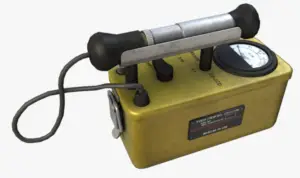
Let assume gaseous ionization detectors. Basic gaseous ionization detector consists of a chamber that is filled with a suitable medium (air or a special fill gas) that can be easily ionized. As a general rule, the center wire is the positive electrode (anode) and the outer cylinder is the negative electrode (cathode), so that (negative) electrons are attracted to the center wire and positive ions are attracted to the outer cylinder. The anode is at a positive voltage with respect to the detector wall. As ionizing radiation enters the gas between the electrodes, a finite number of ion-pairs are formed. Under the influence of the electric field, the positive ions will move toward the negatively charged electrode (outer cylinder), and the negative ions (electrons) will migrate toward the positive electrode (central wire). The collection of these ions will produce a charge on the electrodes and an electrical pulse across the detection circuit. However it is a small signal, this signal can be amplified, and then recorded using standard electronics.
Signal-to-Noise Ratio
Signal-to-noise ratio, SNR, is a measure used in science and engineering that compares the electrical output signal to the electrical noise generated in the cable run or in the instrumentation.
Signal-to-Noise Ratio – Germanium Detectors
Total absorption of a 1 MeV photon produces around 3 x 105 electron-hole pairs. This value is minor in comparison the total number of free carriers in a 1 cm3 intrinsic semiconductor.
Particle passing through the detector ionizes the atoms of semiconductor, producing the electron-hole pairs. But in germanium-based detectors at room temperature, thermal excitation is dominant. It is caused by impurities, irregularity in structure lattice or by dopant. It strongly depends on the Egap (a distance between valence and conduction band), which is very low for germanium (Egap= 0.67 eV). Since thermal excitation results in the detector noise, active cooling is required for some types of semiconductors (e.g. germanium).
Note that, a 1 cm3 sample of pure germanium at 20 °C contains about 4.2×1022 atoms, but also contains about 2.5 x 1013 free electrons and 2.5 x 1013 holes. . As can be seen, the signal to noise ratio (S/N) would be minimal. The addition of 0.001% of arsenic (an impurity) donates an extra 1017 free electrons in the same volume and the electrical conductivity is increased by a factor of 10,000. In doped material the signal to noise ratio (S/N) would be even smaller. Because germanium has relatively low band gap, these detectors must be cooled in order to reduce the thermal generation of charge carriers (thus reverse leakage current) to an acceptable level. Otherwise, leakage current induced noise destroys the energy resolution of the detector.
We hope, this article, Signal-to-Noise Ratio, helps you. If so, give us a like in the sidebar. Main purpose of this website is to help the public to learn some interesting and important information about radiation and dosimeters.